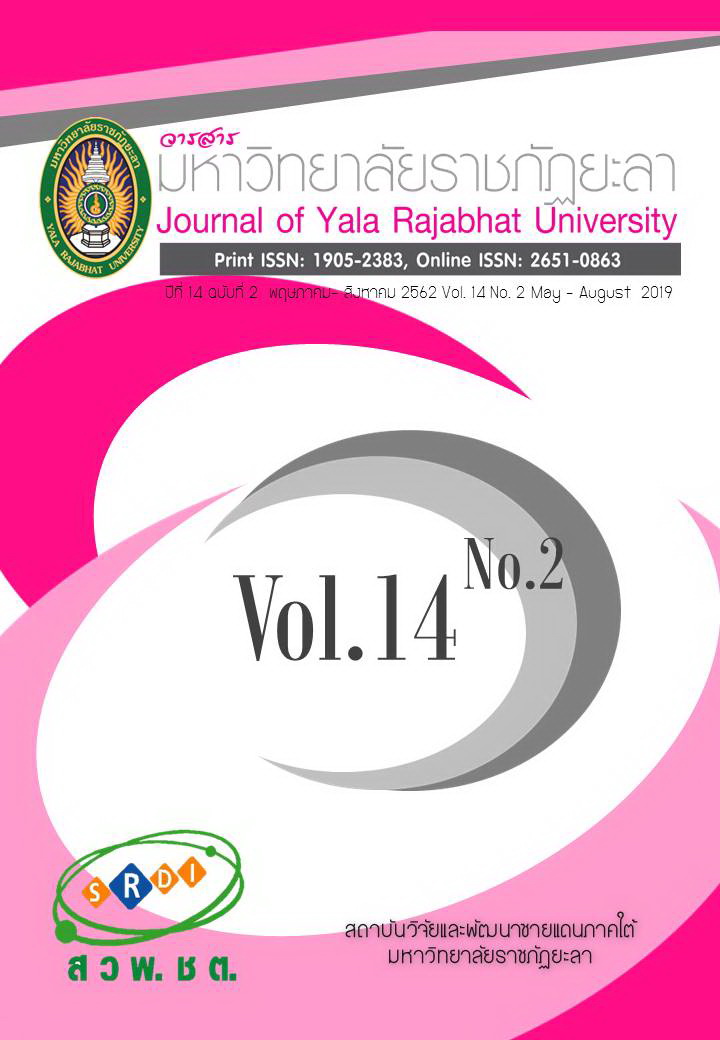รูปแบบการให้บริการการเงินระหว่างประเทศด้วยนวัตกรรมเทคโนโลยีธนาคารอินเทอร์เน็ตของไทย
Main Article Content
บทคัดย่อ
การวิจัยนี้มีวัตถุประสงค์เพื่อ (1) ศึกษาองค์ประกอบของการยอมรับนวัตกรรมเทคโนโลยีธนาคารอินเทอร์เน็ตของการบริการการเงินระหว่างประเทศของไทย และ (2) ศึกษารูปแบบการให้บริการการเงินระหว่างประเทศด้วยนวัตกรรมเทคโนโลยีธนาคารอินเทอร์เน็ตของไทย โดยใช้วิธีวิจัยเชิงคุณภาพ ด้วยการเก็บรวบรวมข้อมูลจากเอกสาร และ ภาคสนามด้วยการสัมภาษณ์เชิงลึกจากผู้ให้ข้อมูลสำคัญ ที่เป็นธนาคารพาณิชย์สัญชาติไทยและต่างชาติที่ให้บริการการเงินระหว่างประเทศในกรุงเทพมหานคร จำนวนทั้งหมด 30 ราย ใช้การสัมภาษณ์เชิงลึกที่มีแนวคำถาม ตรวจสอบข้อมูลแบบสามเส้า ทั้งด้านข้อมูล แหล่งข้อมูลบุคคลจากตัวแทน และ ด้านวิธีการเก็บรวบรวมข้อมูล รวมทั้งการวิเคราะห์ข้อมูลด้วยวิธีการพรรณนาวิเคราะห์ เพื่อให้ได้ข้อมูลที่สำคัญในการสนับสนุนสิ่งที่ผู้ให้ข้อมูลได้กล่าวไว้ ผลการศึกษาพบว่า 1) องค์ประกอบของการยอมรับนวัตกรรมเทคโนโลยีธนาคารอินเทอร์เน็ตของการบริการการเงินระหว่างประเทศของไทย ตามแบบจำลองการยอมรับนวัตกรรมเทคโนโลยี (Technology Acceptance Model : TAM) ประกอบด้วย เพศ อายุ การศึกษา ประสบการณ์ สภาพแวดล้อมสนับสนุน การรับรู้ถึงประโยชน์ที่ได้รับจากนวัตกรรมเทคโนโลยี การรับรู้ว่าเป็นระบบที่ง่ายต่อการใช้งาน และ ทัศนคติที่มีต่อการใช้นวัตกรรมและเทคโนโลยี และ 2) รูปแบบการให้บริการการเงินระหว่างประเทศด้วยนวัตกรรมเทคโนโลยีธนาคารอินเทอร์เน็ตของไทยนั้น มี 3 รูปแบบคือ รูปแบบดั้งเดิม รูปแบบอินเทอร์เน็ตแบบ stand alone และ รูปแบบอินเทอร์เน็ตแบบ online โดยที่องค์ประกอบดังกล่าวส่งผลต่อการพัฒนารูปแบบดั้งเดิม มาจนปัจจุบันเป็นรูปแบบอินเทอร์เน็ตแบบ online
Article Details
บทความ ข้อมูล เนื้อหา รูปภาพ ฯลฯ ที่ได้รับการเผยแพร่ในวารสารมหาวิทยาลัยราชภัฏยะลานี้ ถือเป็นลิขสิทธิ์ของวารสารมหาวิทยาลัยราชภัฏยะลา หากบุคคลหรือหน่วยงานใดต้องการนำทั้งหมดหรือส่วนหนึ่งส่วนใดไปเผยแพร่ต่อหรือกระทำการใดๆ จะต้องได้รับอนุญาตเป็นลายลักษณ์อักษรจากวารสารมหาวิทยาลัยราชภัฏยะลาก่อนเท่านั้น
References
2. Ahn, J. B., Amiti, M. & Weinstein, D. E. (2011). Trade Finance and the Great Trade Collapse. Columbia Business School, 101(3), 298-302.
3. Asmundson, I., Dorsey, T., Khachatryan, A. & Niculcea, I. (2011). Trade and Trade Finance in the 2008-09 Financial Crisis. IMF Working Paper No. WP/11/16, 1-65.
4. Bank of Thailand. (2016). Financial Institutions: Financial Business under the Bank of Thailand’s supervision and examined by the Bank of Thailand as appointed by Ministry of Finance [Online]. Retrived October 25, 2016, from: http://www.bot.or.th/English/FinancialInstiturions. (in Thai)
5. Chaveesuk, S. & Wongjaturapat, S. (2012). Acceptance and Use of Information Technology Theory. KMITL Information Technology Journal, 1(1), 1-21. (in Thai)
6. Export-Import Bank of Thailand. (2012). Type of International Trade Payment Method. Bangkok: Export-Import Bank of Thailand. (in Thai)
7. Fetscherin, M. & Lattemann. (2008). User Acceptance of Virtual Worlds. Journal of Electronic Commerce Research, 9(3), 231-242.
8. International Trade Administration. (2012). Trade Finance Guide: A Quick Reference for U.S. Exporters. United State of America: U.S. Department of Commerce Publishing.
9. Kadir, H. A., Rahmani, N. & Masinaei, R. (2011). Impacts of Service Quality on Customer Satisfaction: Study of Online Banking and ATM Services in Malaysia. International Journal of Trade: Economics and Finance, 2(1), 1-9.
10. Korinek, J., Cocguic, J. L. & Sourdin, P. (2010). The Availability and Cost of Short-Term Trade Finance and its Impact on Trade. Policy Research Working Paper No.5003, World Bank.
11. Ministry of Information and Communication Technology. (2015). Thailand Internet User Profile 2015. Bangkok: Electronic Transaction Development Agency (Public Organization). (in Thai)
12. Morris, M. G., Venkatesh, V. & Ackerman, P. L. (2005). Gender and Age Differences in Employee Decisions about new technology: An Extension to the Theory of Planned Behavior. IEEE Transactions on Engineering Management, 52(1), 69-84.
13. Prete, S. D. & Federico, S. (2012). Trade and Finance: is there more than just trade finance? Evidence from matched bank-firm data. Printing and Publishing Division of the Bank of Italy, 948,1-67.
14. Silicon Valley Bank. (2014). Trade Finance Guide: A Guide and Overview to Export Financing. Trade Information Center, Silicon Valley Bank, United State of America, 8, 1-32.
15. Theron, E. & Terblanche, N. S. (2010). Dimensions of Relationship Marketing in Business-to-Business Financial Services. International Journal of Market Research, 52(3), 383-402.
16. Vainio, H. M. (2006). Factors Influencing Corporate Customers” Acceptance of Internet Banking: Case of Scandinavian Trade Finance Customers. M.Sc.Thesis. The Swedish School of Economics and Business Administration.
17. Venkatesh, V. & Bala, H. (2008). Technology Acceptance Model 3 and a Research Agenda on Interventions. Decision Sciences Institute, 39(2), 273-315.
18. Venkatesh, V., Morris, M. G., Davis, G. B. & Davis, F. D. (2003). User Acceptance of Information Technology: Toward a Unified View. MIS Quarterly, 27, 425-478.

